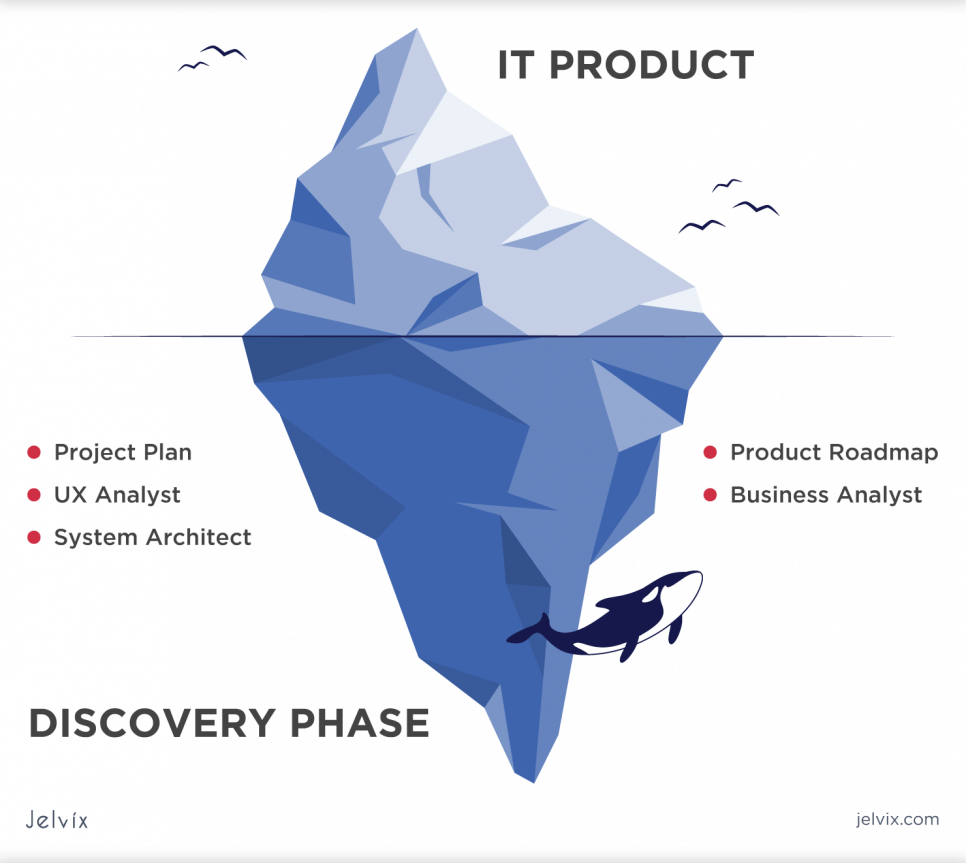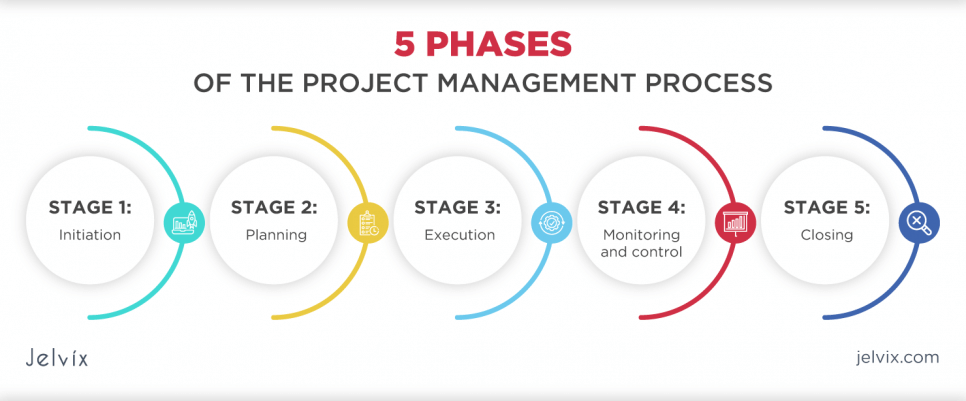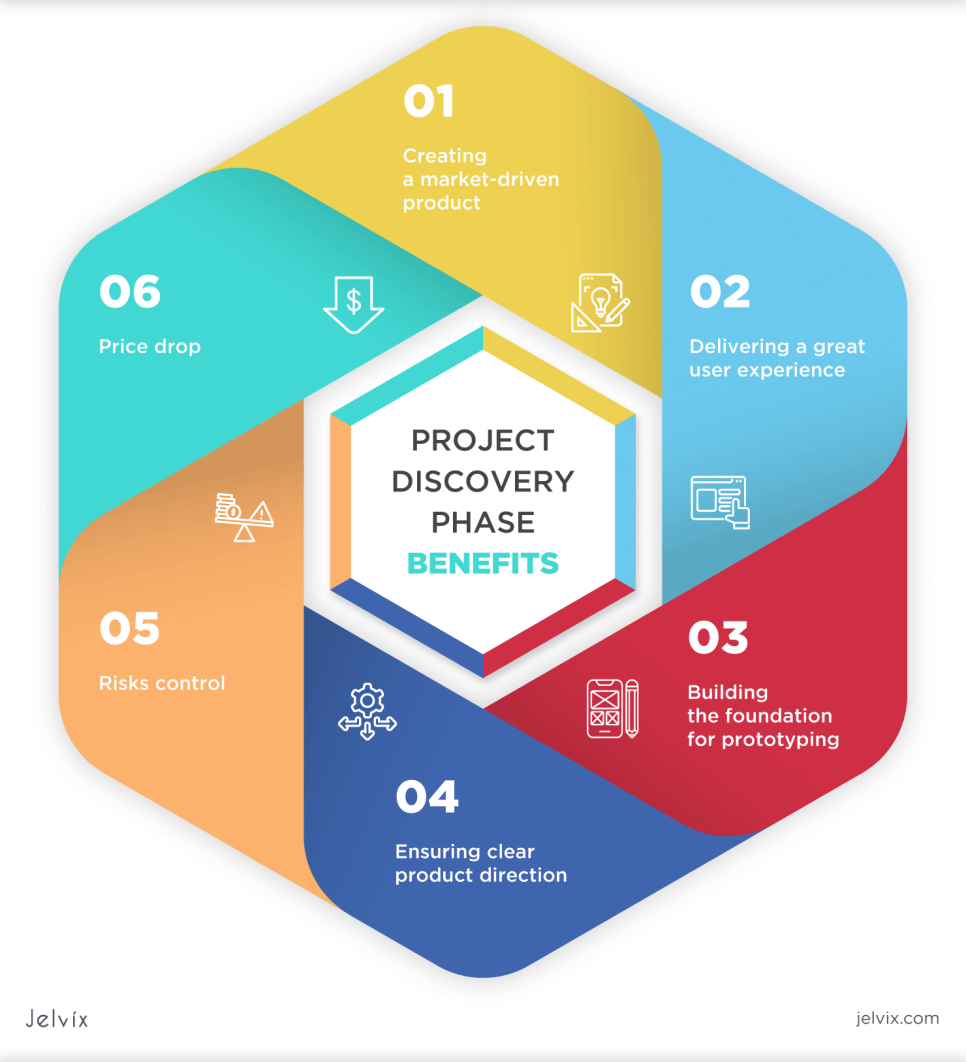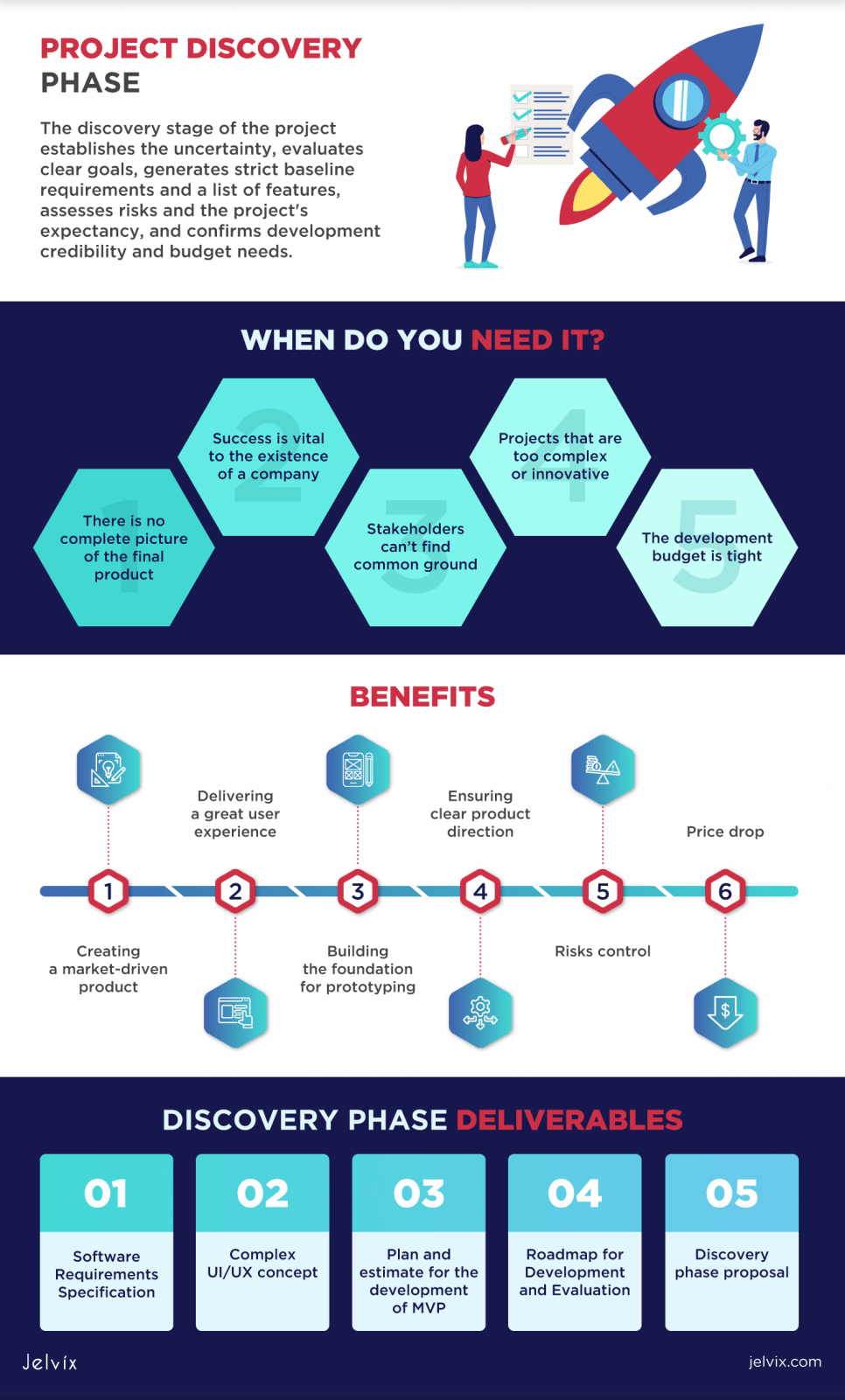New IT projects are born daily, but not all of them hit the spot. Almost 9 of 10 startups fail because they don’t find a target market. In turn, 45% of big projects (>$15 million) face cost overruns due to shifting project requirements and unrealistic schedules.
Surely, your plans do not include missed deadlines, a bloated budget, or, worse, the failure of a project after launch. How can this be avoided? The answer is: do the project discovery phase. It is one of the most important elements of effective project management and is critical to delivering quality products and services.
It will allow you to ensure that the new product meets the market’s needs and your business strategy. Since you can’t afford to neglect this crucial project stage, read more about the discovery phase, its benefits, and key steps.
What Is The Discovery Phase of a Project?
The design discovery phase is the foundation for a data-driven approach to planning and executing software development. Typically, project management is carried out in 5 stages, which include:
- Stage 1: Initiation
- Stage 2: Planning
- Stage 3: Execution
- Stage 4: Monitoring and control
- Stage 5: Closing
None of these stages can be skipped, as each performs unique functions and provides critical information for further product development. When a project goes through the steps in order, the chances of success increase dramatically. Underestimating the value of the early stages before the actual story can lead to budget overruns, project scope creeps, and missed deadlines. But why also add a discovery stage, you ask?
It’s simple — in the discovery phase, you work closely with clients to gather information on their business, goals, obstacles, resources, and current situation. Data-gathering can mean going through company archives, combing through documentation and groundwork, or interviewing related personnel. This process usually involves industry, user, and competitor research, a thorough assessment of appropriate business processes, and prior works by the organization. During the discovery analysis, you also agree on the project’s requirements — what your project needs to accomplish.
Although discovery phase tasks may vary from project to project, they include the following “golden-standard” efforts:
- Business Requirements: what is the project’s result supposed to do for the business?
- Functional Requirements: what functions should the outcome of the undertaking perform?
- Non-functional Requirements: what level of performance is required for the result of the project?
The knowledge gained from this research allows participants to create a customized action plan to deliver the greatest value to the business and achieve the project’s major goals. This comprehensive analysis is a skilled navigator for your product development process.
Learn more about the main stages of product development lifecycle to build a sustainable product.
Why is the Discovery Phase Important?
The research phase is vital for business owners who want to complete their projects on time and within the budget. The discovery stage of a project is necessary for several reasons:
- It helps to make decisions based on useful information and data rather than blindly following assumptions.
- It allows project managers to involve specialists from an early stage to help find a viable solution to the problem.
- You discover the best technology and business solutions.
- It helps design the best user experience, increasing your ROI.
- It permits you to align business goals and strategies with the technology stack and solutions.
- You reduce the likelihood of making costly changes as the development process progresses.
The Project Discovery Phase – Why is it Often Neglected?
There are many reasons companies and startups skip the project’s discovery phase. Sometimes it’s a matter of tight deadlines, sometimes a modest budget, and some even consider that the project discovery is an additional service that does not have to be provided in each project. Occasionally, companies are sure that they know enough and that this is only wasting resources.
But if you jump the project discovery phase altogether, you may have to deal with the following challenges:
- Deadlines were missed because specific milestones were not set, or there was no discussion of results.
- The project quality is compromised and does not meet the expectations of both the client and the contractor.
- There is a sharp increase in costs because of poor budgeting (or lack thereof).
- Scope creep occurs, or clients ask for extensions or additional work.
For example, Peeple, an application supposed to rate people and leave reviews, was closed because of a lack of market interest. Washboard failed to test user pain points and create a product that users would love. Big brands like Google have also lost money by neglecting the discovery phase; remember the case of Google Glasses. It would not have occurred if they had researched their idea and the market.
When is it necessary for the discovery phase of the product?
We list the main points when the discovery process is not only desirable but is of paramount importance:
- There is no complete picture of the final product. You may know what you want to achieve, but your idea is vague and elusive, and you do not know how to turn it into life. In such a situation, the best way is to perform the discovery phase at the beginning of the project.
- Success is vital to the existence of a company. Of course, achieving the goal is always important, but sometimes too much is at stake, and the slightest mistake can lead to bankruptcy.
- Stakeholders can’t find common ground. If many interested parties are engaged in a project, their requirements may conflict. It is normal and solved by engaging analysts. They will help you understand what is needed for the successful implementation of the project.
- Projects that are too complex or innovative. A new product, many competitors, or an exhaustive list of requirements for the final product means that the discovery phase in software development is mandatory.
- The development budget is tight. If your budget is limited and you can’t go over it, the discovery analysis will help you avoid overallocation.
Project Discovery Core Steps
It’s much easier to convince stakeholders of the need for a discovery phase when they know what steps it consists of. Although there is no universal template for the project research phase, the following scenario is typical for the software development sector.
Creating a project discovery team
The discovery team should include a variety of roles with different specialties and areas of interest.
- Product Owner and Stakeholders – explain the project’s goals, vision, and requirements.
- Business Analyst – prepares needs, studies project goals, and explores the project potential from the market perspective.
- Leading designer and UX expert – prepare a prototype and wireframes and analyze the user journey to design a user experience that meets the user’s needs.
- Developer/Technical Expert – select the most viable technical solutions to meet your product’s business needs and prepares technical requirements.
- Project Manager – connects all the roles and ensures that clients and vendors are on the same page.
What should a discovery phase include?
Although the duration of the Discovery phase varies with the complexity of the project, its basic building blocks always remain the same:
- Stakeholder identification. As a rule, it includes the product owner, investors, developers, and other participants.
- Communication between stakeholders. It involves contact between stakeholders until all parties agree upon the vision.
- Review of internal documents and existing research includes viewing and analysis of relevant materials to evaluate the existing solutions and approaches. It may also include additional research or interviews.
- User avatars and user journeys. At this stage, a set of functions is created to help develop a technical solution. It also includes conducting user interviews to understand and solve user problems.
- Competitive analysis. This stage determines the market niche of the solution being developed. The market analysis allows you to identify the strengths and weaknesses of the product, as well as external opportunities and threats.
- Specification of requirements for data analysis and systems. This step converts the dataset into a list of technical and business requirements and benchmarks.
- Deadlines and budget estimates include an estimate of the costs required to complete the project. At this stage, specific deadlines are set for each task with adjustments and revisions.
Discovery Phase Checklist
Like the discovery phase’s core steps, the requirements discovery checklist permits tracking the control points necessary for the quality project execution. The components of this list are as follows:
- Client/Company. The category covers the project’s main objectives, research and marketing materials, and any changes/adjustments rationale.
- Market. A comprehensive study of internal and external aspects using various resources. Submissions may also include industry publications and white papers.
- Competitive analysis. It involves evaluating competitive offers and their sources, classifying competitors and primary and secondary groups. The latter allows you to prioritize risks and quickly respond to eliminate them.
- Current alternatives. They include other offers on the market, namely products or services. Purchase patterns, interaction patterns, customer experience, and other factors are also researched and considered.
- The target audience. This element includes user stories, demographics, and customer avatars.
- Marketing strategy. It includes short-term and long-term goals, branding, and specific approaches needed to promote.
- Technical requirements. They include specifications, solutions, and an updated technology package.
- Other data and information. This element allows you to complete the missing parts. It is critical to ensure that all stakeholders are involved in this process to ensure that the checklist is complete.
Discovery Phase Deliverables
The deliverables to be presented to the client during the discovery phase are based solely on the tasks underlying this project stage. If the main goal of the discovery is planning the development workflow, deliverables will respectively consist of various aspects of the process.
But if you initiate the discovery phase for the software project, you receive the following pinpoints (depending on the needs of the project at a particular point in time):
-
- Software Requirements Specification. The document fully describes the project, including recommended features, technical stack, architecture structure, appropriate third-party solutions, security tips, etc.
- Complex UI/UX concept. We are talking about the technical design concept of a website or mobile service. Such a concept ideally comprises two parts:
- Wireframes. A rough sketch preliminarily shows the future UI/UX infrastructure. This will help you understand which screens you need to include in your interactive prototype.
- Interactive prototype. It may not look exactly like the final product – website or mobile app, but it is detailed and realistic enough to showcase all the interactions. The prototype helps you test the actual user experience before you start development.
- A plan and estimate for the development of MVP. You will receive the estimated composition of the team and an accurate estimate of the development timeline and budget. Numbers based on the discovery phase, prototype, and SRS are unlikely to change in the process and not interfere with your business goals.
- Roadmap for Development and Evaluation. You will receive the recommended team composition, development budget estimates, and deadlines. The final numbers calculated during the customer discovery phase are unlikely to change (unless the project scope varies during development).
- Discovery phase proposal. A development process proposal based on Discovery’s findings will help ensure that the project team creates a product that meets all the client’s requirements and needs.
What is the discovery phase of an agile project?
The discovery phase in a modern Agile management structure is usually placed in the first sprint. That helps determine how well the development team and the client understand each other from the beginning. The discovery phase depends on the project’s complexity and the amount of work. The average times are:
- For a small project – 1-3 days.
- For an average project – 1-3 weeks.
- For a large project – at least 4-5 weeks or more.
How much will the product discovery phase cost?
The project opening stage costs vary from company to company, but on average, it is 10% of the development budget. After the initial idea discussion, the developers already have a rough idea of what needs to be created and how it should work. Therefore, the discovery stage price can tell you in advance about the cost of the final product – MVP or large-scale application.
Project Discovery Phase is a Huge Benefit
As outlined in the previous sections, we strongly suggest you do a discovery step. So, let’s look at the main benefits you can get without skipping.
Creating a market-driven product
Doing the research phase of a design allows you to test your design idea with users rather than relying on assumptions. It puts you on the right track by defining your target audience and modeling your vision and business goals.
For example, let’s take the confrontation between Facebook and MySpace – identical social networks in concept and key functions. However, Facebook overtook MySpace because of the perfect match of the market, target audience, and launch timeline.
In other words, the Facebook team catches an early trend and offers a market-driven product without creating disruptive innovations. The discovery phase may allow you to do the same.
Delivering a great user experience
A discovery phase is also great for identifying the problems you will solve with the application. By communicating with users, you will learn their pain points and turn them into additional features of the application. Ignoring the user is dangerous. It’s easy to create functionality or content that no one cares about, which is a tremendous waste of money. Conversely, by listening to your users’ opinions, you can create a product that focuses on user experience.
Building the foundation for prototyping
Creating a prototype is the best way to test an idea with user research. Think of a product prototype as a simplified version of the final product. It aims to test the product’s usability, design, and functionality.
This “something” is the information collected at the project opening stage. However, the prototype is still far from a final product to build upon. So without Discovery, it would not be easy to make a great prototype and test the idea.
Ensuring clear product direction
In product development, there is such a thing as a software requirements specification. In simple words, this is the plan for the entire development process and the structure of the team involved in the project. It is the roadmap for your future web or mobile application.
The SRS helps keep the development process consistent and the project team members aware of their work.
The research phase of the project sheds light on the complexity and functionality of the project. It defines the required effort during the design, development, testing, and project management phases. To create it, you need a discovery phase in project management. With a clear direction for the application, the story can start with clear milestones and possibly less cost.
Risks control
There are always risks when doing something new. So many things can go wrong; according to Murphy’s law, if they can, they will. But with a flexible discovery stage, you can save a lot of money, visualize your target clearly, and prevent missed deadlines. Project risks will be more regulated, too, helping everyone feel more at ease as things progress.
Price drop
A very important benefit you will get during a software project’s research phase is the overall cost reduction. Proper documentation and a well-coordinated team will help reduce the cost of your application development process. Hence, it will make your product competitive in the market.
Conclusion
Both the company professionals and the client benefit from the discovery phase digital service because clear requirements are set, features are discussed, the budget is known and the timeframe is decided. Completion of the discovery phase of the project provides an opportunity to make an informed decision to prioritize or reject development. It offers the chance to identify the income from an investment before the development, not after it.
Now you see how the product discovery phase is crucial to your business. But to properly justify the discovery phase and its results, you will require the great technical skills that Jelvix has. Jelvix projects are based on properly organized project management and we are happy to provide our experience for you and share the advantages of the discovery phase. We will not only carry out the discovery stage professionally but also provide a full scope of services, including creating the digital system itself.
Implement your business idea with Jelvix
Get the best solutions ever to satisfy your target users’ needs. You’ll also enjoy a reasonable cost estimation of the project implementation.
















